A Yeovil Armory
A Yeovil Armory
Arms of families connected with Yeovil
Most of the following images of shields of arms are based on Leslie Brooke's "A Yeovil Armory" held in the Tite Collection, Yeovil Library.
![]()
Arms of Roger Arundel
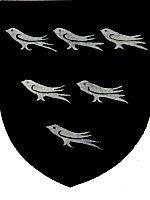 The
Manor of Lyde had its own
entry in the
Domesday Book with a total
of five
households and
in the time of
King Edward was
held by Godwin and Saeric.
The
post-Conquest tenant-in-chief
was
"Rogerius
Arundel",
thought to be
most likely a
kinsman of Roger
de Montgomeri,
and Azelin was
under-tenant.
The family were
considerable
land owners in
Somerset and
elsewhere. The
arms of Arundel
were - sable,
six swallows
argent, 3, 2, 1
(on a black
field, six
silver swallows,
three over two
over one).
The
Manor of Lyde had its own
entry in the
Domesday Book with a total
of five
households and
in the time of
King Edward was
held by Godwin and Saeric.
The
post-Conquest tenant-in-chief
was
"Rogerius
Arundel",
thought to be
most likely a
kinsman of Roger
de Montgomeri,
and Azelin was
under-tenant.
The family were
considerable
land owners in
Somerset and
elsewhere. The
arms of Arundel
were - sable,
six swallows
argent, 3, 2, 1
(on a black
field, six
silver swallows,
three over two
over one).
Arms of Bermondsey Priory, before 1399
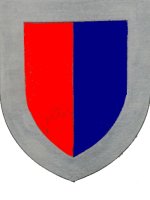 By 1104
William of
Mortain, who
took part in the
unsuccessful
rising against
William Rufus, had
succeeded his
father as
tenant-in-chief
of his Yeovil
lands. He was
banished by
Henry I and
these lands, the
future Manor of
Kingston
reverted to the
crown. William
was forced to
become a monk at
the
newly-established Cluniac priory
at Bermondsey. The
pre-1399 arms of
Bermondsey
Priory were -
per pale gules
and azure, a
bordure argent
(a divided field
of red and blue
with a silver
border).
By 1104
William of
Mortain, who
took part in the
unsuccessful
rising against
William Rufus, had
succeeded his
father as
tenant-in-chief
of his Yeovil
lands. He was
banished by
Henry I and
these lands, the
future Manor of
Kingston
reverted to the
crown. William
was forced to
become a monk at
the
newly-established Cluniac priory
at Bermondsey. The
pre-1399 arms of
Bermondsey
Priory were -
per pale gules
and azure, a
bordure argent
(a divided field
of red and blue
with a silver
border).
Arms of Bermondsey Priory, after 1399
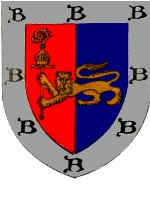 The
Monks of
Bermondsey were
to maintain two
chaplains to
serve Preston
Bermondsey
chapel. Ansger's
son, Walter,
added two hides
at Stone, which
became the
detached portion
of the parish. The
post-1399 arms
of Bermondsey
Priory were -
per pale gules
and azure, over
all a lion
passant guardant
holding a
pastoral staff enfiled with a
mitre or, a
bordure argent
charged with
eight letters B,
argent (a
divided field of
red and blue
with a golden
walking lion,
his head facing,
holding a
crozier piercing
a mitre. A
silver border
with eight
letters B).
The
Monks of
Bermondsey were
to maintain two
chaplains to
serve Preston
Bermondsey
chapel. Ansger's
son, Walter,
added two hides
at Stone, which
became the
detached portion
of the parish. The
post-1399 arms
of Bermondsey
Priory were -
per pale gules
and azure, over
all a lion
passant guardant
holding a
pastoral staff enfiled with a
mitre or, a
bordure argent
charged with
eight letters B,
argent (a
divided field of
red and blue
with a golden
walking lion,
his head facing,
holding a
crozier piercing
a mitre. A
silver border
with eight
letters B).
Arms of Bide
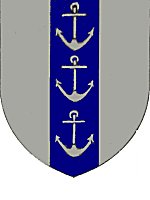 William
Bide, who
died in 1829,
left to his son
William his
'new-built'
glove factory in
Reckleford.
In 1841 William
was employing
200 men, 60 boys
and 2,000 women
in the gloving
trade. He died
in 1864 having
been an
Alderman,
Mayor of
Yeovil and a
Borough
Magistrate.
William
Bide, who
died in 1829,
left to his son
William his
'new-built'
glove factory in
Reckleford.
In 1841 William
was employing
200 men, 60 boys
and 2,000 women
in the gloving
trade. He died
in 1864 having
been an
Alderman,
Mayor of
Yeovil and a
Borough
Magistrate.
The Bide arms were argent, on a pale azure three anchors erect of the field (on a silver shield, a blue vertical stripe a third of the shield wide containing three anchors displayed upright).
Arms of Bingham - ancient
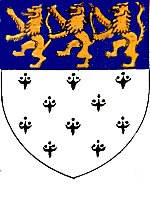 William
de Bingham held
the custody of
lands in West
Marsh and
Kingston in the
fourteenth
century. A seal
on a grant of
1353 shows the
arms as here,
with the words "Sigillum
Willielmi de
Bingham"
(seal of William
Bingham).
William
de Bingham held
the custody of
lands in West
Marsh and
Kingston in the
fourteenth
century. A seal
on a grant of
1353 shows the
arms as here,
with the words "Sigillum
Willielmi de
Bingham"
(seal of William
Bingham).
The arms were described as ermine, on a chief azure three lions rampant, or (a shield of the fur ermine with the top third blue containing three golden lions, rearing up).
Arms of Bingham - modern
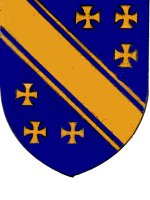 The
Bingham family,
besides holding
lands in Yeovil
Marsh and
Kingston, were
also resident at
Sutton Bingham.
The
Bingham family,
besides holding
lands in Yeovil
Marsh and
Kingston, were
also resident at
Sutton Bingham.
Superseding the arms shown above, the modern Bingham arms are described as azure, a bend cottised between six crosses patèe or (on a blue shield with a golden a straight stripe extending from the left (as viewed) corner to the opposite edge of the shield and with matching parallel side-stripes, between six golden crosses with spreading ends).
Arms of Botreaux - ancient
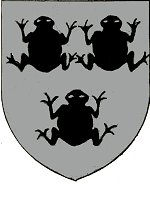 John
Botreaux, third
and youngest son
of William, Lord
Botreaux of
North Cadbury,
was a co-founder
of the
Chantry of the
Holy Cross
in
St John's church
in 1432, in
honour of his
wife Alice. He
endowed it with
lands in
Kingston.
John
Botreaux, third
and youngest son
of William, Lord
Botreaux of
North Cadbury,
was a co-founder
of the
Chantry of the
Holy Cross
in
St John's church
in 1432, in
honour of his
wife Alice. He
endowed it with
lands in
Kingston.
The arms were argent, three toads erect, 2, 1, sable (on a silver field, three upright black toads, two above the third).
Arms of Burnell
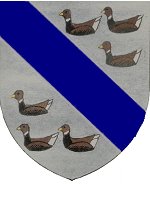 The
estate of Newton
Surmaville came
to the Burnell
family in 1442.
John Burnell
sold the estate
to John Compton
in 1510. The
arms of this
family are
recorded by
Gerard of Trent
in his
'particular
description' of
Somerset in
1633.
The
estate of Newton
Surmaville came
to the Burnell
family in 1442.
John Burnell
sold the estate
to John Compton
in 1510. The
arms of this
family are
recorded by
Gerard of Trent
in his
'particular
description' of
Somerset in
1633.
The arms were argent, a bend azure between six Brent geese proper (on a silver shield a blue straight stripe extending from the left (as viewed) corner to the opposite edge of the shield, between six Brent geese in natural colours).
Arms of Burton
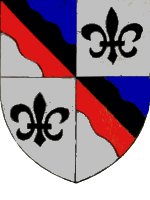 These
arms appear on
the west wall of
the south
transept of St
John's church on
a memorial to
Edward Burton
(d1777) and his
wife Elizabeth
(d1766).
These
arms appear on
the west wall of
the south
transept of St
John's church on
a memorial to
Edward Burton
(d1777) and his
wife Elizabeth
(d1766).
The arms were quarterly, 1 & 4 per bend argent and azure, a bend per bend wavy sable and gules; 2 & 3 argent a fleur-de-lys sable (quarters 1 & 4 a silver and blue field divided diagonally and surmounted by a wavy black and red line, quarters 2 & 3 with a silver field and a black fleur-de-lys).
Arms of Cantelupe
 William
Cantelupe held
Kingston Manor
in 1204, in
wardship of a de
Say minor. The
family also
appended their
name to Chilton
Cantelo.
William
Cantelupe held
Kingston Manor
in 1204, in
wardship of a de
Say minor. The
family also
appended their
name to Chilton
Cantelo.
The arms were gules, three leopards' heads jessant-de-lys or (on a red field, three golden leopards heads - in heraldic terms the face of a lion - each with a fleur-de-lys passing through it).
Arms of Carent
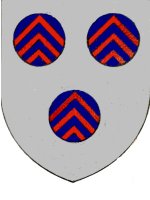 The
Carent family
were first
connected with
Yeovil in 1324,
and held lands
in Kingston and
Marsh until the
late sixteenth
century and
their name is
perpetuated in
Carent's Farm.
The
Carent family
were first
connected with
Yeovil in 1324,
and held lands
in Kingston and
Marsh until the
late sixteenth
century and
their name is
perpetuated in
Carent's Farm.
The arms were argent, three roundels chevrony gules and azure (on a silver field, three roundels of red and blue chevrons).
Arms of Chideock
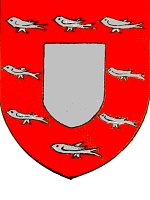 The
manor and
advowson of the
Rectory of
Kingston came to
the Chideocks by
a daughter of
Robert Fitzpaine
in 1344, passing
to the Holland
family, Earls of
Kent, towards
the end of the
reign of Richard
the Second.
The
manor and
advowson of the
Rectory of
Kingston came to
the Chideocks by
a daughter of
Robert Fitzpaine
in 1344, passing
to the Holland
family, Earls of
Kent, towards
the end of the
reign of Richard
the Second.
The Chideock arms were gules, an escutcheon and an orle of martlets argent (on a red field, a silver shield and a border of silver martlets - birds like swallows with thighs but no visible legs).
Arms of Compton
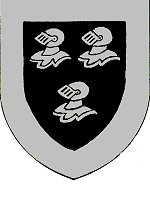 John
Compton of
Beckington
acquired Newton
Surmaville from
John Burnell in
1510. His
grandson,
another John
Compton, sold
Newton to Robert
Harbyn of Wyke,
near Gillingham,
Dorset, in 1608.
John
Compton of
Beckington
acquired Newton
Surmaville from
John Burnell in
1510. His
grandson,
another John
Compton, sold
Newton to Robert
Harbyn of Wyke,
near Gillingham,
Dorset, in 1608.
The arms were sable, three helmets within a bordure argent (three silver helmets on a shield with a black field and a silver border.
Arms of Crewkerne
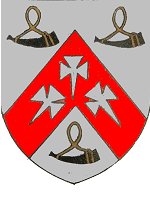 These
arms are shown
on the brass of
Gyles and
Isabell Penne
in St John's
church, through
the arms of
Gyles' mother's
family, the
Crewkernes of
Childhay,
Dorset. The
tinctures shown
here are as
recorded in 1633
by Gerard.
The arms were
argent, on a
chevron gules,
between three
bugle horns
sable stringed
or, as many
cross crosslets patèe fitchée argent (on a silver
field, a red chevron
between three
black bugle
horns with
golden strings,
three silver
crosses with
spreading ends
and pointed
lower ends).
These
arms are shown
on the brass of
Gyles and
Isabell Penne
in St John's
church, through
the arms of
Gyles' mother's
family, the
Crewkernes of
Childhay,
Dorset. The
tinctures shown
here are as
recorded in 1633
by Gerard.
The arms were
argent, on a
chevron gules,
between three
bugle horns
sable stringed
or, as many
cross crosslets patèe fitchée argent (on a silver
field, a red chevron
between three
black bugle
horns with
golden strings,
three silver
crosses with
spreading ends
and pointed
lower ends).
Arms of Dampier
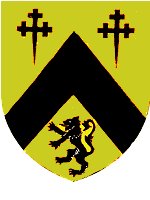 Thomas
William Dampier,
born 1844, only
son of
Thomas Dampier
of Kingston
Manor, assumed
the additional
surname of Bide
and quartered
the Bide arms
(see above) with
his own by Royal
Licence under
the terms of the
will of his
maternal uncle, William
Bide.
Thomas
William Dampier,
born 1844, only
son of
Thomas Dampier
of Kingston
Manor, assumed
the additional
surname of Bide
and quartered
the Bide arms
(see above) with
his own by Royal
Licence under
the terms of the
will of his
maternal uncle, William
Bide.
The arms were or, a chevron between, in chief, two cross crosslets fitchée and, in base, a lion rampant, sable (on a golden field, a black chevron with two black crosses with pointed lower ends above and a black standing lion).
Arms of Daniell
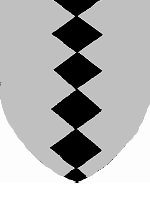 The
Daniell family
was associated
with Yeovil from
at least the
early 18th
century. They
were in
residence at
Penn House early
in the 19th
century and also
at Hendford
House, now the
manor hotel, as
well as a very
large house in
Middle Street.
In addition to
being glovers,
linen-drapers
and mercers,
John Daniel the
elder became a
banker.
The
Daniell family
was associated
with Yeovil from
at least the
early 18th
century. They
were in
residence at
Penn House early
in the 19th
century and also
at Hendford
House, now the
manor hotel, as
well as a very
large house in
Middle Street.
In addition to
being glovers,
linen-drapers
and mercers,
John Daniel the
elder became a
banker.
The arms were argent, a pale fusilly sable (on a silver field a black horizontal stripe made of lozenge shapes).
Arms of Donn
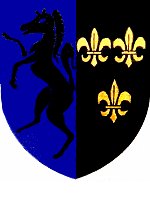 The
Donn family are
commemorated in
a memorial in St
John's church,
bearing these
arms, recording
the death of
mercer William
Donn
(1692-1757), his
wife Jane
1694-1770) and
their sons
William
(1723-1754) and
Henry
(1725-1794).
Henry was Custos
of Woborn
Almshouse for
many years. The
arms were azure,
a horse rampant
sable, impaling
sable, three
fleurs-de-lys 2,
1, or
('impaling' is
setting side by
side two coats
of arms in the
same shield;
here a rearing
black horse on a
blue field and
three golden
fleurs-de-lys,
two over one, on
a black field).
The
Donn family are
commemorated in
a memorial in St
John's church,
bearing these
arms, recording
the death of
mercer William
Donn
(1692-1757), his
wife Jane
1694-1770) and
their sons
William
(1723-1754) and
Henry
(1725-1794).
Henry was Custos
of Woborn
Almshouse for
many years. The
arms were azure,
a horse rampant
sable, impaling
sable, three
fleurs-de-lys 2,
1, or
('impaling' is
setting side by
side two coats
of arms in the
same shield;
here a rearing
black horse on a
blue field and
three golden
fleurs-de-lys,
two over one, on
a black field).
Arms of Dyer
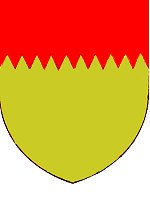 John
Dyer was the
last vicar to be
presented by the
Abbess of Syon.
The will of
'John Dyar of
Yevyll' of 1554
mentions his
wife Elizabeth,
sons Stephin and
John, and a
daughter Johan.
John Dyar,
churchwarden,
was 'Robin
Hood' in
1577.
John
Dyer was the
last vicar to be
presented by the
Abbess of Syon.
The will of
'John Dyar of
Yevyll' of 1554
mentions his
wife Elizabeth,
sons Stephin and
John, and a
daughter Johan.
John Dyar,
churchwarden,
was 'Robin
Hood' in
1577.
The arms were or, a chief indented gules (on a golden field, a red chief - the first of the Ordinaries, and occupying about one-third of the shield from the top downward - with its edge notched with small teeth).
Arms of Fane
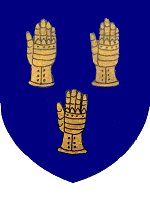 Thomas
Fane of
Brympton, later
Earl of
Westmoreland,
acquired the
Manor of Preston
Plucknett from
William Cox, a
timber merchant.
The manor passed
to his daughter,
Lady Georgiana
Fane in 1841.
Thomas
Fane of
Brympton, later
Earl of
Westmoreland,
acquired the
Manor of Preston
Plucknett from
William Cox, a
timber merchant.
The manor passed
to his daughter,
Lady Georgiana
Fane in 1841.
The arms were azure, three dexter gauntlets, backs affronty or (on a blue field, three golden right-hand gauntlets with the backs facing the onlooker).
Arms of Fitzalan, Earls of Arundel
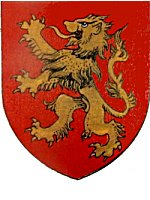 John Maltravers'
granddaughter
married John
Fitz Alan, a
younger son of
the Earl of
Arundel. As a
consequence the
advowson of
Yeovil passed to
the Arundels. In
1415 Thomas, the
13th Earl of
Arundel, sold
the lordship and
advowson to
Henry V but kept
the
Manor of
Hendford. The Arundels kept
the Manor of
Hendford until
Henry Fitzalan
(1512-1580),
19th Earl of
Arundel,
exchanged it
with Queen
Elizabeth in
1561. The arms of Fitzalan, Earls
of Arundel were
gules, a lion
rampant or (on a
red field, a
golden standing
lion).
John Maltravers'
granddaughter
married John
Fitz Alan, a
younger son of
the Earl of
Arundel. As a
consequence the
advowson of
Yeovil passed to
the Arundels. In
1415 Thomas, the
13th Earl of
Arundel, sold
the lordship and
advowson to
Henry V but kept
the
Manor of
Hendford. The Arundels kept
the Manor of
Hendford until
Henry Fitzalan
(1512-1580),
19th Earl of
Arundel,
exchanged it
with Queen
Elizabeth in
1561. The arms of Fitzalan, Earls
of Arundel were
gules, a lion
rampant or (on a
red field, a
golden standing
lion).
Arms of Fitzpaine
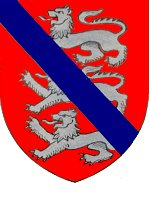 Sir
Robert Fitzpaine
acquired the
Manor of
Kingston from
John de Wigdon
circa 1315. His
son, also
Robert, also
held the Manor
of Lyde in the
right of his
wife Margaret.
Kingston manor
passed from the
Fitzpaines to
the Chideocks in
1344.
Sir
Robert Fitzpaine
acquired the
Manor of
Kingston from
John de Wigdon
circa 1315. His
son, also
Robert, also
held the Manor
of Lyde in the
right of his
wife Margaret.
Kingston manor
passed from the
Fitzpaines to
the Chideocks in
1344.
The arms were gules, three lions passant in pale argent, debruised by a bend azure (on a red field, three silver lions walking past, beneath one another with a blue stripe over them).
Arms of Freke
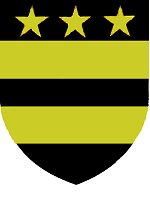 In
1705 Thomas
Freke of Bristol
bought part of
Preston
Bermondsey from
the King family.
Philip Freke
bought the
remained of
Preston
Bermondsey from
the Moore family
in 1709. Thomas
acquired
Philip's
holdings, and
other properties
between 1710 and
1716. An heir,
John Freke, sold
the manor to
John Butler in
1787.
The Freke family arms were
sable, two
bars or in chief
three mullets of
the last
(a black
field with two
horizontal
golden bars, the
top third of the
field - the
first of the
Ordinaries -
containing three
golden stars
representing the
rowels of spurs).
In
1705 Thomas
Freke of Bristol
bought part of
Preston
Bermondsey from
the King family.
Philip Freke
bought the
remained of
Preston
Bermondsey from
the Moore family
in 1709. Thomas
acquired
Philip's
holdings, and
other properties
between 1710 and
1716. An heir,
John Freke, sold
the manor to
John Butler in
1787.
The Freke family arms were
sable, two
bars or in chief
three mullets of
the last
(a black
field with two
horizontal
golden bars, the
top third of the
field - the
first of the
Ordinaries -
containing three
golden stars
representing the
rowels of spurs).
Arms of Goodford impaling Cholmeley
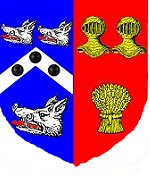 In
1846 Henry
Goodford was
owner of a
considerable
amount of land,
including the
cottage still
standing in
Mudford Road
known as
Goodford's Folly
that includes
these arms,
dated 1821.
In
1846 Henry
Goodford was
owner of a
considerable
amount of land,
including the
cottage still
standing in
Mudford Road
known as
Goodford's Folly
that includes
these arms,
dated 1821.
The Goodford arms were azure on a chevron between three boars' heads argent langued and couped gules as many pellets (on a blue field, a central silver chevron with three black roundels set between three boar's heads - two above the chevron, one below - with red tongues, the heads cut short.
The Cholmeley arms were gules, two helmets in chief and a garb in base or (on a red field two gold helmets at the top over a gold sheaf of corn at the bottom).
Arms of Harbin
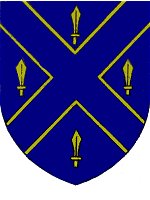 In
May 1612 these
arms were
granted to
Robert Harbin by
William Camden,
Elizabeth I's
Officer of Arms.
This date with
the initials RH
appear on lead
water pipes at
Newton
Surmaville as
the new manor
house was
completed,
replacing the
earlier
residence of the
Compton family.
The arms were
azure, a
saltire voided
between four
spears' head
erect or (a
blue field, a
golden saltire
cross with the
middle removed
so the field is
visible, between
four golden
erect spear
heads).
In
May 1612 these
arms were
granted to
Robert Harbin by
William Camden,
Elizabeth I's
Officer of Arms.
This date with
the initials RH
appear on lead
water pipes at
Newton
Surmaville as
the new manor
house was
completed,
replacing the
earlier
residence of the
Compton family.
The arms were
azure, a
saltire voided
between four
spears' head
erect or (a
blue field, a
golden saltire
cross with the
middle removed
so the field is
visible, between
four golden
erect spear
heads).
Arms of Harbin impaling Wyndham
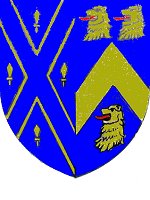 The
arms of Harbin
impaling Wyndham
appear on a
memorial on the
west wall of St
John's church
and date from
1673 when
William Harbin
of Newton
Surmaville
married
Elizabeth,
daughter of Sir
Francis Wyndham,
Bart, of Trent.
Their combined
ages were 36.
The
arms of Harbin
impaling Wyndham
appear on a
memorial on the
west wall of St
John's church
and date from
1673 when
William Harbin
of Newton
Surmaville
married
Elizabeth,
daughter of Sir
Francis Wyndham,
Bart, of Trent.
Their combined
ages were 36.
The Wyndham arms were azure, a chevron between three lions' heads erased or (on a blue field, a golden chevron between three golden lions' heads, torn off leaving a ragged edge).
Arms of Holland
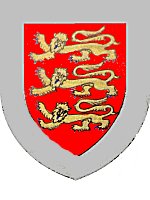 Towards
the end of the
reign of Richard
II (1377-1399),
the Manor of
Kingston was in
possession of
the Earls of
Kent, the first
of whom was
Thomas de
Holland,
half-brother of
Richard II. He
was authorised
to use the royal
lions of England
within a silver
border in place
of his previous
arms. The arms
were gules,
three lions
passant guardant
or, within a
border argent
(on a red
field, three
passing golden
lions with faces
turned to the
onlooker, all
within a silver
border.
Towards
the end of the
reign of Richard
II (1377-1399),
the Manor of
Kingston was in
possession of
the Earls of
Kent, the first
of whom was
Thomas de
Holland,
half-brother of
Richard II. He
was authorised
to use the royal
lions of England
within a silver
border in place
of his previous
arms. The arms
were gules,
three lions
passant guardant
or, within a
border argent
(on a red
field, three
passing golden
lions with faces
turned to the
onlooker, all
within a silver
border.
Arms of Holme
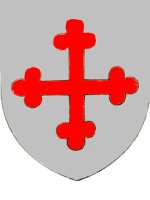 Gerard
recorded these
are in 1633 as
those of John
Holme, who came
to possess
Newton
Surmaville
through the
death of his
father-in-law,
John Musket, in
1373. Musket's
heir was his
daughter Agnes,
wife of John
Holme.
Gerard
recorded these
are in 1633 as
those of John
Holme, who came
to possess
Newton
Surmaville
through the
death of his
father-in-law,
John Musket, in
1373. Musket's
heir was his
daughter Agnes,
wife of John
Holme.
The arms were argent, a cross botonné gules (on a silver field, a red cross with the ends shaped like a trefoil).
Arms of Hooper
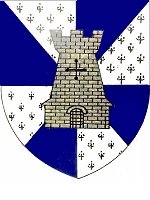 Burke's
'General Armory'
records these as
the arms of
Thomas Hooper of
Hendford. The
Hoopers lived in
Hendford Manor
until the 1830s.
The Hoopers were
long associated
with Yeovil;
Stephen Hooper
(d post 1452)
owned property
in Grope Lane
and another
Stephen gave the
9th and tenor
bells to St
John's church in
1626.
Burke's
'General Armory'
records these as
the arms of
Thomas Hooper of
Hendford. The
Hoopers lived in
Hendford Manor
until the 1830s.
The Hoopers were
long associated
with Yeovil;
Stephen Hooper
(d post 1452)
owned property
in Grope Lane
and another
Stephen gave the
9th and tenor
bells to St
John's church in
1626.
The arms were gyronny of eight ermine and azure, over all a tower argent (on a field of eight triangles of ermine and blue, a silver tower).
Arms of Horsey
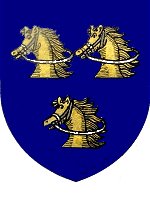 The
Manor of Yeovil,
its rectory,
lands and
property of Holy
Trinity Chantry
in St John's
church were
leased to Sir
John Horsey of
Clifton Maybank
by the Abbess
and Convent of
Syon. The
Horseys remained
in possession of
the lordship
until 1610.
Their name is
perpetuated in
Horsey Lane,
previously the
whole of
West Hendford.
The arms were
azure, three
nags' heads
couped or,
bridled argent
(on a blue
field, three
golden horses
heads cut off in
a straight line,
with silver
bridles).
The
Manor of Yeovil,
its rectory,
lands and
property of Holy
Trinity Chantry
in St John's
church were
leased to Sir
John Horsey of
Clifton Maybank
by the Abbess
and Convent of
Syon. The
Horseys remained
in possession of
the lordship
until 1610.
Their name is
perpetuated in
Horsey Lane,
previously the
whole of
West Hendford.
The arms were
azure, three
nags' heads
couped or,
bridled argent
(on a blue
field, three
golden horses
heads cut off in
a straight line,
with silver
bridles).
Arms of Maltravers
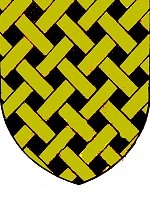 Hugh
Maltravers held
of William d'Ow
six of the eight
hides which
comprised Yeovil
in 1086. The advowson of
St John's was
finally
separated from
Hendford Manor
in 1334 and from
1339 it was
granted
absolutely to
John Maltravers.
The advowson
remained with
the Maltravers
until the line
ended with his
granddaughters
and coheirs,
Joan and
Eleanor, at his
death in 1350.
At the death of
Joan without
issue, Eleanor
became de
jure
Baroness
Maltravers. The
original
Maltravers arms
were sable,
fretty or
(on a black
field, a
continuous
golden fret).
Hugh
Maltravers held
of William d'Ow
six of the eight
hides which
comprised Yeovil
in 1086. The advowson of
St John's was
finally
separated from
Hendford Manor
in 1334 and from
1339 it was
granted
absolutely to
John Maltravers.
The advowson
remained with
the Maltravers
until the line
ended with his
granddaughters
and coheirs,
Joan and
Eleanor, at his
death in 1350.
At the death of
Joan without
issue, Eleanor
became de
jure
Baroness
Maltravers. The
original
Maltravers arms
were sable,
fretty or
(on a black
field, a
continuous
golden fret).
Arms of Milles
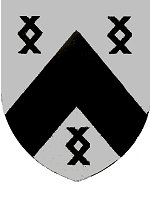 Thomas
Milles was born
at Newton
Surmaville in
1827, the son of
Thomas Potter
Milles and
Elizabeth,
daughter of
William Harbin.
His memorial, on
the west wall of
the north
transept of St
John's church
shows him to
have been
Major-General in
the 1st Gordon
Highlanders. He
died in 1903 and
was buried at
Sidmouth.
The arms were
argent, a
chevron between
three mill-rinds
sable ( on
a silver field a
black chevron
between three
black mill-rinds
- iron pieces
supporting a
mill stone).
Thomas
Milles was born
at Newton
Surmaville in
1827, the son of
Thomas Potter
Milles and
Elizabeth,
daughter of
William Harbin.
His memorial, on
the west wall of
the north
transept of St
John's church
shows him to
have been
Major-General in
the 1st Gordon
Highlanders. He
died in 1903 and
was buried at
Sidmouth.
The arms were
argent, a
chevron between
three mill-rinds
sable ( on
a silver field a
black chevron
between three
black mill-rinds
- iron pieces
supporting a
mill stone).
Arms of Neal
 This
crest appears on
a memorial on
the east wall of
the south
transept of St
John's church,
to John Neal who
died in 1847,
aged 65. There
is also a
memorial window
in the church to
William Neal,
who died in 1834
aged 62 and is
believed to be
John's father.
The arms were
paly of six
argent and
azure, on a bend
gules, a
greyhound's head
erased between
two dexter hands
couped at the
wrist argent
(on a field of
silver and blue
divided
perpendicularly,
a diagonal red
stripe with a
silver
greyhound's
head, violently
torn off,
between two
silver left
hands cut
straight across
the wrist).
This
crest appears on
a memorial on
the east wall of
the south
transept of St
John's church,
to John Neal who
died in 1847,
aged 65. There
is also a
memorial window
in the church to
William Neal,
who died in 1834
aged 62 and is
believed to be
John's father.
The arms were
paly of six
argent and
azure, on a bend
gules, a
greyhound's head
erased between
two dexter hands
couped at the
wrist argent
(on a field of
silver and blue
divided
perpendicularly,
a diagonal red
stripe with a
silver
greyhound's
head, violently
torn off,
between two
silver left
hands cut
straight across
the wrist).
Arms of Newman impaling Mompesson
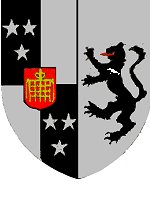 John
Newman, a roper
'of Kingston
juxte Yeovil',
was the son of
Francis Holles
Newman and
Eleanor,
daughter of
Thomas Mompesson,
and left in his
will messuages,
tenements and
hereditaments in
Yeovil and
Kingston. The
inescutcheon was
granted to
Richard Newman
(d1664).
John
Newman, a roper
'of Kingston
juxte Yeovil',
was the son of
Francis Holles
Newman and
Eleanor,
daughter of
Thomas Mompesson,
and left in his
will messuages,
tenements and
hereditaments in
Yeovil and
Kingston. The
inescutcheon was
granted to
Richard Newman
(d1664).
The arms of Newman were quarterly sable and argent, in the first and fourth three mullets of the second, an inescutchen gules charged with a portcullis regally crowned or (a field quartered black and silver, with three silver stars in 1 and 4, with a single red escutcheon with a golden portcullis with a royal crown). The arms of Mompesson were argent, a lion rampant sable, on the shoulder a martlett of the first (on a silver field, a rearing black lion with a silver bird resembling a swallow on its shoulder).
Arms of Northumberland
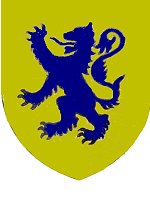 The
Earls of
Northumberland
became heirs to
the Poyning
estates which
included Lyde.
The
Earls of
Northumberland
became heirs to
the Poyning
estates which
included Lyde.
The arms were or, a lion rampant azure (on a golden field a rearing blue lion).
Arms of Paynter
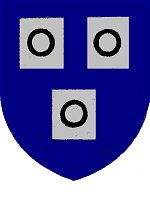 James
Bernard Paynter
of Hendford
Manor, provided
the installation
of electricity
in St John's
church in the
early part of
1925.
James
Bernard Paynter
of Hendford
Manor, provided
the installation
of electricity
in St John's
church in the
early part of
1925.
The arms were azure, three blocks argent each charged with an annulet sable (on a blue field, three silver rectangles - in this instance a slightly widened version of a billet - each with a small black ring).
Arms of Penny
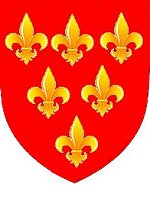 The
memorial to
Henry Penny
(1778-1855) on
the west wall of
the north aisle
of St John's
church bears the
arms granted to
the Penny
family, of whom
Giles Penne was
a member,
subsequent to
his death.
The
memorial to
Henry Penny
(1778-1855) on
the west wall of
the north aisle
of St John's
church bears the
arms granted to
the Penny
family, of whom
Giles Penne was
a member,
subsequent to
his death.
The arms were gules, six fleurs-de-lys or, 3, 2, 1 (on a red field, six golden fleurs-de-lys, three over two, over one).
Arms of Phelips
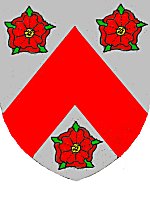 The
The Phelips
family had very
close links with
Yeovil for 300
years. Sir
Edward Phelips,
the builder of
Montacute House,
was granted the
Lordship of
Yeovil by James
I in 1611. The
family continued
to hold the
Lordship until
1846 when
William Phelips
sold it to
George Harbin of
Newton
Surmaville.
The
The Phelips
family had very
close links with
Yeovil for 300
years. Sir
Edward Phelips,
the builder of
Montacute House,
was granted the
Lordship of
Yeovil by James
I in 1611. The
family continued
to hold the
Lordship until
1846 when
William Phelips
sold it to
George Harbin of
Newton
Surmaville.
The arms were argent, a chevron between three roses gules, barbed and seeded proper (on a silver field, a red chevron between three red roses with naturally-coloured leaves and centres).
Arms of Plugenet
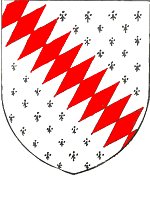 Sir
Alan Plugenet
(or Ploknet) who
gave
Preston
Plucknett
his name, was
excommunicated
in 1315 for
having refused
to bury his
mother according
to her wishes
and also for
assaulting the
Rural Dean and
forcing him to
eat the deed of
citation.
Sir
Alan Plugenet
(or Ploknet) who
gave
Preston
Plucknett
his name, was
excommunicated
in 1315 for
having refused
to bury his
mother according
to her wishes
and also for
assaulting the
Rural Dean and
forcing him to
eat the deed of
citation.
The arms of Plugenet were ermine, a bend fusilly gules (on a field of the fur ermine, a red diagonal stripe made of lozenge shapes).
Arms of Poynings
 The
Poynings family
were sometime
owners of Lyde.
Sir Richard was
involved with
the early days
of Woborn
Almshouse. He
and his wife,
Eleanor, were
among those for
whom a chaplain
was to perform a
daily service
either in the
almshouse chapel
or in St John's
church.
The
Poynings family
were sometime
owners of Lyde.
Sir Richard was
involved with
the early days
of Woborn
Almshouse. He
and his wife,
Eleanor, were
among those for
whom a chaplain
was to perform a
daily service
either in the
almshouse chapel
or in St John's
church.
The Poynings arms were barry of six or and vert, a bendlet jules (on a field horizontally divided into six golden and green stripes, a narrow red diagonal stripe).
Arms of Prowse
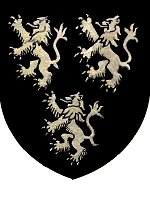 The
earliest known
member of the
Prowse family,
recorded on a
brass on the
floor of the
chancel of St
John's church,
is George Prowse
who died in
1624. The
family's main
residence was in
Kingston. John
Prowse bought
the manor house
in 1710.
The
earliest known
member of the
Prowse family,
recorded on a
brass on the
floor of the
chancel of St
John's church,
is George Prowse
who died in
1624. The
family's main
residence was in
Kingston. John
Prowse bought
the manor house
in 1710.
The Prowse arms were sable, three lions rampant, argent (on a black field, three rearing silver lions).
Arms of Rede
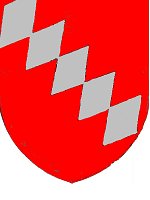 William
le Rede was
Provost of
Yeovil in the
reign of Edward
I. In the
Exchequer Lay
Subsidies for
Yeovil of 1327,
a William le
Rede of Yeovil
is shown as
paying 15d,
while in 1399 a
John Rede was
presented as
Vicar of Yeovil
by the King.
William
le Rede was
Provost of
Yeovil in the
reign of Edward
I. In the
Exchequer Lay
Subsidies for
Yeovil of 1327,
a William le
Rede of Yeovil
is shown as
paying 15d,
while in 1399 a
John Rede was
presented as
Vicar of Yeovil
by the King.
The Rede arms were gules, a bend lozengy argent (on a red field, a silver diagonal band made of lozenges or diamonds).
Arms of Say
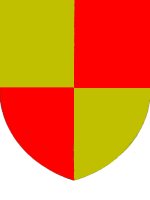 The
Manor of
Kingston was
held by the de
Say family soon
after the
Conquest. It
continued in
their possession
until the
thirteenth
century when the
inheritance
passed to two
daughters of
Richard de Say;
Edith who
married Thomas
de Huntley and
Matilda who
married Thomas
de Arderne.
The
Manor of
Kingston was
held by the de
Say family soon
after the
Conquest. It
continued in
their possession
until the
thirteenth
century when the
inheritance
passed to two
daughters of
Richard de Say;
Edith who
married Thomas
de Huntley and
Matilda who
married Thomas
de Arderne.
The arms were quarterly or and gules ( a quartered field of gold and red).
Arms of Seward
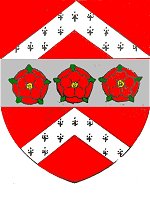 John
Seward became
Vicar of Yeovil
in 1580. Ambrose
Seward, issuer
of a
trade token
bearing a cross
patèe
John
Seward became
Vicar of Yeovil
in 1580. Ambrose
Seward, issuer
of a
trade token
bearing a cross
patèe
Arms of Spencer
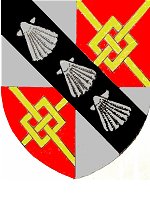 Sir
John Spencer
acquired the
Manor of
Hendford from
Elizabeth I in
1599. On his
death in 1633
the manor passed
to his daughter
Elizabeth, wife
of William,
second Lord
Compton, who
became Earl of
Northampton. The
Spencer arms
were
quarterly argent
and gules, in
the second and
third a fret or,
overall a bend
sable charged
with three
escallops of the
first (on a
quartered field
of silver and
red, with a
golden fret in
the second and
third, a black
diagonal band
with three
silver
scallops).
Sir
John Spencer
acquired the
Manor of
Hendford from
Elizabeth I in
1599. On his
death in 1633
the manor passed
to his daughter
Elizabeth, wife
of William,
second Lord
Compton, who
became Earl of
Northampton. The
Spencer arms
were
quarterly argent
and gules, in
the second and
third a fret or,
overall a bend
sable charged
with three
escallops of the
first (on a
quartered field
of silver and
red, with a
golden fret in
the second and
third, a black
diagonal band
with three
silver
scallops).
Arms of Stourton
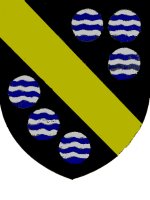 Sir
John Stourton of
Preston
Plucknett left
40 shillings to
the fabric of
the church of
Yeovil in 1438.
As well as
Preston, he
owned Brympton
and Pendomer,
and was uncle of
the first Lord
Stourton. Of his
three daughters,
Joan took
Brympton to John
Sydenham, Cicely
took Preston to
John Hill and
Alice took
Pendomer to
William Daubeny.
The arms of
Stourton were
sable, a
bend or between
six fountains
(on a black
field, a golden
diagonal stripe
between the
representation
of six
fountains).
Sir
John Stourton of
Preston
Plucknett left
40 shillings to
the fabric of
the church of
Yeovil in 1438.
As well as
Preston, he
owned Brympton
and Pendomer,
and was uncle of
the first Lord
Stourton. Of his
three daughters,
Joan took
Brympton to John
Sydenham, Cicely
took Preston to
John Hill and
Alice took
Pendomer to
William Daubeny.
The arms of
Stourton were
sable, a
bend or between
six fountains
(on a black
field, a golden
diagonal stripe
between the
representation
of six
fountains).
Arms of Upton
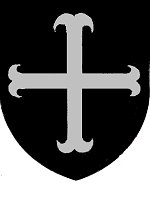 These
arms appear on a
memorial on the
west wall of the
south aisle of
St John's church
to
George
Proctor Upton
(1763-1827) and
his wife Eleanor
née Leach
(1761-1848).
These
arms appear on a
memorial on the
west wall of the
south aisle of
St John's church
to
George
Proctor Upton
(1763-1827) and
his wife Eleanor
née Leach
(1761-1848).
The arms of Upton are sable, a cross moline argent (a black field charged with a silver cross having bifurcated ends).
Arms of Waldegrave
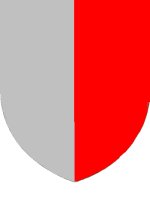 The
Manor of Preston
Plucknett was
shared by four
cousins
following the
death of Sir
William Say in
1529, one of
whom was John
Waldegrave. By
1599 he had
acquired the
whole of his
cousins'
holdings. He
settled it on
the marriage of
his eldest son,
Edward, with
Elinor Lovell
and it continued
in the
Waldegrave
family until it
was sold to
Edward Phelips
in 1725.
The
Manor of Preston
Plucknett was
shared by four
cousins
following the
death of Sir
William Say in
1529, one of
whom was John
Waldegrave. By
1599 he had
acquired the
whole of his
cousins'
holdings. He
settled it on
the marriage of
his eldest son,
Edward, with
Elinor Lovell
and it continued
in the
Waldegrave
family until it
was sold to
Edward Phelips
in 1725.
The arms were per pale argent and gules (a divided field of silver and red).
Arms of Wigton
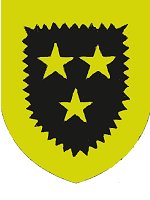 Walter
de Wigton was in
possession of
the Manor of
Kingston during
the reign of
Edward I. He
died in 1286 and
the estate was
inherited by his
22-year old son,
John, who,
before his death
about 1316, sold
Kingston to
Robert Fitzpaine.
The name, as
Wigdon, survived
as the
designation
given to East
Marsh. The arms
of Wigton were
sable, three
mullets and a
bordure indented
or (on a
black field with
a golden
indented border,
three golden
stars
representing
rowels of
spurs).
Walter
de Wigton was in
possession of
the Manor of
Kingston during
the reign of
Edward I. He
died in 1286 and
the estate was
inherited by his
22-year old son,
John, who,
before his death
about 1316, sold
Kingston to
Robert Fitzpaine.
The name, as
Wigdon, survived
as the
designation
given to East
Marsh. The arms
of Wigton were
sable, three
mullets and a
bordure indented
or (on a
black field with
a golden
indented border,
three golden
stars
representing
rowels of
spurs).
Arms of Wyndham
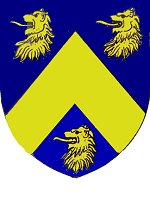 The
Wyndhams of
nearby Trent had
long
associations
with Yeovil and
intermarried
with the Harbin
family, as seen
in the impaled
arms of Harbin
and Wyndham
above.
The
Wyndhams of
nearby Trent had
long
associations
with Yeovil and
intermarried
with the Harbin
family, as seen
in the impaled
arms of Harbin
and Wyndham
above.
The Wyndham arms were azure, a chevron between three lions' heads erased or (on a blue field, a golden chevron between three golden lions' heads, torn off leaving a ragged edge).